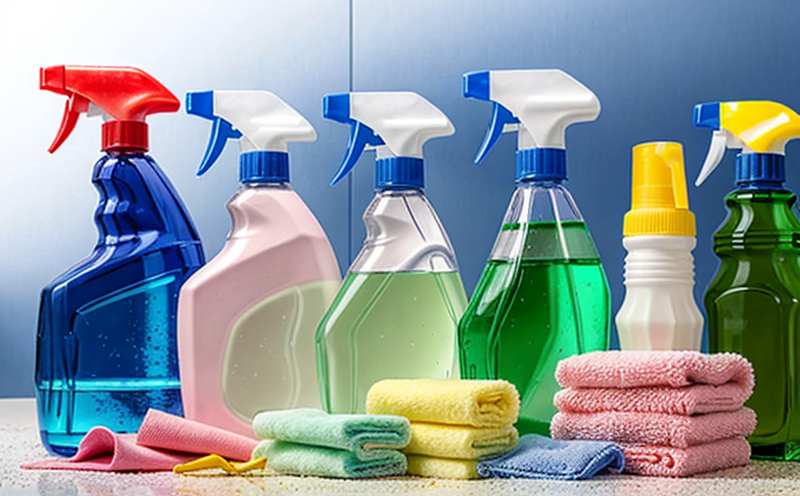Child-Resistant Packaging Testing of Cleaning Agents
The child-resistance testing of cleaning agents is a critical aspect of product safety and compliance. This service ensures that packaging designed to prevent access by children meets the required standards, thereby protecting public health and safety.
In the consumer products sector, especially for hazardous substances like cleaning agents, it's essential to have robust child-resistant packaging. The regulations governing this are stringent because even a small amount of these chemicals can be harmful if ingested by children or pets. Compliance with industry standards is not only a legal requirement but also an ethical responsibility.
The testing process involves several key steps. Initially, the package undergoes a series of simulated child attempts to open it. This phase assesses the ease of opening for intended adults while ensuring that children cannot easily access the contents. Afterward, a seal integrity test is conducted to verify that once closed, the container remains securely sealed.
Instrumentation plays a crucial role in this testing process. The equipment used includes specialized mannequins designed to mimic child-like hands and techniques for opening packaging. These tools are calibrated to ensure accurate measurements of both ease of opening and seal integrity. Additionally, the use of high-resolution imaging devices helps in identifying any defects or weaknesses in the design that could compromise the effectiveness of the package.
The testing criteria are based on internationally recognized standards such as ASTM F1397-02(2018), which specify detailed procedures for evaluating child-resistant closures. Compliance with these guidelines ensures not only legal adherence but also a higher level of consumer confidence in the product safety measures implemented by manufacturers.
Real-world scenarios often highlight the importance of thorough testing. For instance, during recalls or incidents involving children accessing cleaning products, it's clear that rigorous pre-market assessments are necessary to avoid such unfortunate occurrences. By adhering strictly to these standards and undergoing comprehensive evaluation processes, companies can significantly reduce risks associated with their products.
Another critical aspect is ensuring the appropriateness of the child-resistant packaging for various types of cleaning agents. Different formulations may require different designs in terms of size, shape, and material composition to maintain effective child resistance while maintaining usability for adults. This tailored approach ensures that all users can safely interact with the product as intended.
In summary, child-resistance testing is a vital component of safeguarding public health by preventing accidental ingestion of harmful substances found in cleaning agents. Through meticulous evaluation processes and adherence to established standards, laboratories like ours provide assurance that products meet necessary safety requirements.
Benefits
Ensures compliance with strict international standards, thus avoiding legal penalties and reputational damage.
Reduces the risk of accidental ingestion by children, contributing to public health and safety.
Enhances consumer confidence in product safety through rigorous testing processes.
Provides a competitive edge by demonstrating commitment to quality and regulatory compliance.
Facilitates smoother market entry into regions with stringent packaging regulations.
International Acceptance and Recognition
The child-resistant packaging testing service is widely accepted across various countries worldwide. Many nations have adopted similar standards to protect public health, making compliance essential for global brands. For instance, the United States has strict regulations under the Poison Prevention Packaging Act (PPPA) of 1970, while Europe follows directives related to packaging safety.
Recognition from authoritative bodies such as the World Health Organization (WHO) further emphasizes the importance and necessity of this testing in maintaining global standards. Laboratories adhering to these practices are often accredited by recognized agencies like ANSI or ISO, ensuring credibility and reliability for clients operating internationally.
By aligning with international best practices, companies not only meet legal requirements but also contribute positively towards public health initiatives globally. This collaborative effort underscores the shared responsibility among manufacturers, regulators, and consumers in creating safer environments.
Environmental and Sustainability Contributions
In addition to enhancing product safety, child-resistant packaging testing can have positive environmental impacts when done thoughtfully. For example, using recyclable materials or designing packages that are easier to recycle supports broader sustainability goals. Manufacturers who prioritize eco-friendly practices contribute significantly to reducing waste and conserving resources.
Moreover, by ensuring the safe use of cleaning products through appropriate packaging design, companies help prevent accidental spills or improper disposal, which could lead to environmental contamination. This proactive approach aligns with broader corporate social responsibility efforts aimed at minimizing harm to ecosystems.
The testing process itself also contributes indirectly by driving innovation in sustainable packaging solutions. Laboratories and manufacturers work closely together to develop safer yet more environmentally friendly alternatives without compromising on effectiveness or ease of use.





